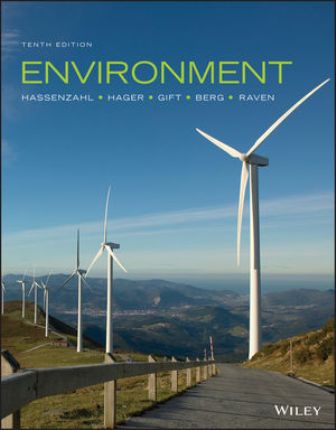Instant download Test Bank for Environment, 10th Edition, David M. Hassenzahl, Mary Catherine Hager, Nancy Y. Gift, Linda R. Berg, Peter H. Raven pdf docx epub after payment.

Product details:
- ISBN-10 : 1119393485
- ISBN-13 : 978-1119393481
Author: David M. Hassenzahl; Mary Catherine Hager; Nancy Y. Gift
Environment, Tenth Edition helps students understand the connection between the core concepts of the Environmental Science and their daily lives. The 10th edition enhanced e-text features a rich, interactive collection of current case studies and in-text examples, which provides students with the tools to understand, apply, and think critically about environmental science. It also provides instructors with powerful tools to assess individual students progresses well as the class as a whole.
Table of contents:
1 Introducing Environmental Science and Sustainability 1
Human Impacts on the Environment 1
Increasing Human Numbers 2
Development, Environment, and Sustainability 3
Population, Resources, and the Environment 4
Types of Resources 4
Resource Consumption 5
Ecological Footprint 6
The IPAT Model 6
Sustainability 8
Sustainability and the Tragedy of the Commons 9
Global Plans for Sustainable Development 9
Environmental Science 10
Earth Systems and Environmental Science 11
Science as a Process 11
Addressing Environmental Problems 15
Addressing Environmental Problems 15
Environmental Science in Practice: Lake Washington 16
2 Environmental Laws, Economics, and Ethics 21
A Brief Environmental History of the United States 21
Protecting Forests 22
Establishing and Protecting National Parks and Monuments 22
Conservation in the Mid-20th Century 23
The Environmental Movement of the Late 20th Century 24
U.S. Environmental Legislation 26
Environmental Policy Since 1970 27
Economics and the Environment 29
Strategies for Pollution Control 31
Critiques of Environmental Economics 32
Natural Resources, the Environment, and National Income Accounts 32
Environmental Ethics, Values, and Worldviews 34
Environmental Ethics 34
Environmental Worldviews 35
Environmental Justice 36
3 Ecosystems and Energy 41
What Is Ecology? 42
The Energy of Life 44
The First Law of Thermodynamics 45
The Second Law of Thermodynamics 46
Photosynthesis and Cellular Respiration 46
Case in Point Life Without the Sun 47
The Flow of Energy through Ecosystems 48
Producers, Consumers, and Decomposers 48
The Path of Energy Flow: Who Eats Whom in Ecosystems 49
Case in Point How Humans Have Affected the Antarctic Food Web 51
Ecological Pyramids 52
Ecosystem Productivity 53
Human Impact on Net Primary Productivity 54
4 Ecosystems and the Physical Environment 57
The Cycling of Materials within Ecosystems 57
The Carbon Cycle 58
The Nitrogen Cycle 60
The Phosphorus Cycle 61
The Sulfur Cycle 64
The Hydrologic Cycle 65
Solar Radiation 66
Temperature Changes with Latitude 67
Temperature Changes with the Seasons 68
The Atmosphere 68
Layers of the Atmosphere 68
Atmospheric Circulation 69
The Global Ocean 71
Patterns of Circulation in the Ocean 71
Vertical Mixing of Ocean Water 72
Ocean Interactions with the Atmosphere 73
Weather and Climate 75
Precipitation 75
Tornadoes 76
Tropical Cyclones 78
Case in Point Hurricane Katrina 79
Internal Planetary Processes 79
Earthquakes 80
Volcanoes 81
5 Ecosystems and Living Organisms 85
Evolution: How Populations Change Over Time 85
Natural Selection 86
Modern Synthesis 86
Evolution of Biological Diversity: The Organization of Life 87
Principles of Population Ecology 89
Population Density 90
How Do Populations Change in Size? 90
Maximum Population Growth 91
Environmental Resistance and Carrying Capacity 91
Factors that Affect Population Size 93
Reproductive Strategies 94
Survivorship 95
Metapopulations 95
Biological Communities 96
The Ecological Niche 97
Competition 98
Symbiosis 99
Predation 102
Keystone Species 103
Species Richness in a Community 104
Species Richness, Ecosystem Services, and Community Stability 105
Case in Point Gardens as Ecosystems 106
Community Development 106
Primary Succession 107
Secondary Succession 108
6 Major Ecosystems of the World 113
Earth’s Major Biomes 113
Tundra: Cold Boggy Plains of the Far North 114
Boreal Forests: Conifer Forests of the North 116
Temperate Rain Forests: Lush Temperate Forests 117
Temperate Deciduous Forests: Trees That Shed Their Leaves 118
Grasslands: Temperate Seas of Grass 118
Chaparral: Thickets of Evergreen Shrubs and Small Trees 119
Deserts: Arid Life Zones 120
Savanna: Tropical Grasslands 121
Tropical Rain Forests: Lush Equatorial Forests 122
Vertical Zonation: The Distribution of Vegetation on Mountains 123
Aquatic Ecosystems 124
Freshwater Ecosystems 124
Case in Point The Everglades 128
Estuaries: Where Fresh Water and Salt Water Meet 129
Marine Ecosystems 130
7 Human Health and Environmental Toxicology 140
Human Health 140
Health Issues in Highly Developed Countries 141
Health Issues in Developing Countries 142
Emerging and Reemerging Diseases 142
Influenza Pandemics Past and Future 144
Environmental Pollution and Disease 144
Persistence, Bioaccumulation, and Biological Magnification of Environmental Contaminants 145
Endocrine Disrupters 147
Determining Health Effects of Environmental Pollution 148
Identifying Toxic Substances 149
Children and Chemical Exposure 151
Decision Making and Uncertainty: Assessment of Risks 152
Risk Information as a Decision Tool 153
Ecological Risk Assessment 156
Ecological Risk Assessment and Ecotoxicology 157
Case in Point The Ocean and Human Health 158
8 The Human Population 161
The Science of Demography 161
Current and Future Population Numbers 162
Human Migration 163
Demographics of Countries 163
Demographic Stages 164
Age Structure 166
Population and Quality of Life 168
Case in Point Coping with AIDS in Africa 169
Population and Chronic Hunger 169
Economic Effects of Continued Population Growth 170
Reducing the Total Fertility Rate 170
Culture and Fertility 171
The Social and Economic Status of Women 171
Family Planning Services 173
Government Policies, Fertility, and Poverty 173
China and Mexico: Contrasting Population Growth Measures 174
The United Nations Sustainable Development Goals 175
9 The Urban Environment 179
Population and Urbanization 179
Characteristics of the Urban Population 180
Urbanization Trends 180
The City as an Ecosystem 183
Long-Term Study of Urban Ecosystems 184
Environmental Problems Associated with Urban Areas 185
Environmental Benefits of Urbanization 187
Urban Land-Use Planning 187
Transportation and Urban Development 188
Suburban Sprawl 189
Making Cities More Sustainable 190
Case in Point Curitiba, Brazil 192
10 Energy Consumption 196
Energy Consumption and Policy 196
Energy Consumption 197
Energy Efficiency and Conservation 199
Energy Efficiency 200
Energy Conservation 205
Electricity, Hydrogen, and Energy Storage 205
Electricity 206
Hydrogen and Fuel Cells 206
Energy Storage 208
Energy Policy 210
Four Energy Policy Objectives 210
Climate Energy Policy and Climate Change 211
11 Fossil Fuels 214
Fossil Fuels 215
How Fossil Fuels Formed 215
Fossil Fuels, the Carbon Cycle, and Climate 216
Coal 216
Coal Reserves 217
Coal Mining 217
Safety Problems Associated with Coal 218
Environmental Impacts of the Mining Process 218
Environmental Impacts of Burning Coal 218
Making Coal a Cleaner Fuel 219
Coal and Carbon Dioxide Emissions 220
Oil and Natural Gas Extraction and Consumption 221
Sources and Uses of Oil and Natural Gas Resources 221
Oil and Natural Gas Extraction and Consumption 223
Environmental Impacts of Oil and Natural Gas 226
Deepwater Horizon Oil Spill 227
Exxon Valdez Oil Spill 228
The Arctic National Wildlife Refuge 229
Synfuels and Other Potential Fossil-Fuel Resources 229
Environmental Impacts of Synfuels 231
12 Renewable Energy and Nuclear Power 234
Direct Solar Energy 234
Heating Buildings and Water 235
Solar Thermal Electricity Generation 237
Photovoltaics 238
Indirect Solar Energy 239
Energy From Biomass 239
Wind Energy 240
Hydropower 242
Case in Point The Three Gorges Dam 243
Other Uses of Indirect Solar Energy 243
Other Renewable Energy Sources 244
Geothermal Energy 244
Tidal Energy 245
Nuclear Energy 246
Pros and Cons of Nuclear Energy 247
Nuclear Power Plant Safety and Radioactive Waste 249
Case in Point Yucca Mountain 251
13 Water: A Limited Resource 255
The Importance of Water 255
Properties of Water 256
The Hydrologic Cycle and Our Supply of Fresh Water 256
Water Use and Resource Problems 259
Too Much Water 259
Case in Point Flood Control on the Mississippi River 260
Too Little Water 261
Water Problems in the United States and Canada 262
Surface Water 263
Groundwater 265
Global Water Problems 266
Water and Climate Change 267
Drinking-Water Problems 267
Population Growth and Water Problems 267
Sharing Water Resources Among Countries 268
Water Management 271
Providing a Sustainable Water Supply 271
Water Conservation 274
Reducing Agricultural Water Waste 274
Reducing Industrial Water Waste 275
Reducing Municipal Water Waste 275
14 Soil Resources 280
The Soil System 280
State Factors: Soil-Forming Factors 281
Soil Composition 281
Soil Horizons 283
Soil Organisms 283
Nutrient Cycling 284
Soil Properties and Major Soil Types 285
Soil Acidity 286
Major Soil Groups 286
Environmental Problems Related to Soil 288
Soil Erosion 288
Case in Point The American Dust Bowl 289
Nutrient Mineral Depletion 290
Soil Salinization 291
Desertification 291
Soil Conservation and Regeneration 292
Conservation Tillage 292
Crop Rotation 293
Contour Plowing, Strip Cropping, and Terracing 293
Preserving Soil Fertility 293
Soil Reclamation 294
Agroforestry 295
Soil Conservation Policies in the United States 296
15 Mineral Resources 299
Introduction to Minerals 299
Mineral Distribution and Formation 301
How Minerals are Found, Extracted, and Processed 301
Environmental Impacts Associated with Minerals 304
Mining and the Environment 304
Environmental Impacts of Refining Minerals 305
Case in Point Copper Basin, Tennessee 306
Restoration of Mining Lands 307
Minerals: An International Perspective 308
Worldwide Mineral Production and Consumption 308
Mineral Distribution Versus Consumption 309
Evaluating Our Mineral Supplies 309
Increasing the Supply of Minerals 310
Locating and Mining New Deposits 310
Minerals in Antarctica 310
Minerals from the Ocean 311
Advanced Mining and Processing Technologies 311
Using Substitution and Conservation to Expand Mineral Supplies 312
Finding Mineral Substitutes 312
Mineral Conservation 313
16 Biological Resources 318
Biological Diversity 318
People also search:
Environment, 10th Edition
Environment, 10th Edition pdf
Environment
environmental engineering
conda create environment
environment and society geography





